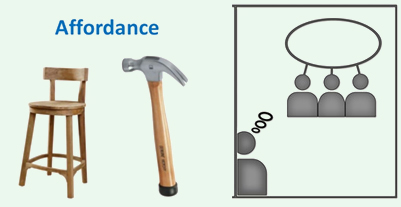Thursday, 1 November 2018
How the Concept of Affordances Has Evolved

Recently, I had the chance to realize how quickly a concept can change—in this case, the concept of affordances, In its original form, this concept first appeared in studies by James J. Gibson on the sense of sight, in the 1970s. In short, Gibson observed that when we see an object, what interests us the most is not so much its physical properties as the opportunities that it affords us to take action—to intervene more effectively in the world and thus better resist the ravages of time, or, in the elegant language of physics, to temporarily overcome the second law of thermodynamics, that entropy always increases.
For some years, this concept of affordances received little attention in cognitive science, because the prevailing highly computationalist paradigm, emphasizing inputs, manipulation of symbols, and outputs, militated against its full development. This is a common phenomenon in the history of ideas: a conceptual innovation that is just a bit ahead of its time does not fit into any existing, broader paradigm that would let the scientific community understand and embrace its full implications.
For the concept of affordances, such a paradigm finally emerged in the 1990s: embodied cognition, which treats the mind and the body as a unified whole and was presented in books such as The Embodied Mind: Cognitive Science and Human Experience, by Varela, Thompson and Rosch. Then, in the 2000s, what came to be known as the pragmatic turn in cognitive science occurred, in which mental processes came to be seen less as a means of representing the world descriptively and more as means of acting upon it. This seemingly minor change in fact had revolutionary implications. For example, the affordance-competition hypothesis proposed by Paul Cisek and his colleagues completely reversed the prevailing understanding that the brain first decides what action it wants to take, and then prepares to take it. Instead, according to this hypothesis, the brain first pre-selects a range of potential actions, represented by different coalitions of neurons, These coalitions then compete, and the one that wins carries out the action that it embodies.
As you may have guessed, these potential actions that the brain is constantly evoking come from the affordances in the environment in which the human body/mind exists, And that brings me to the subject of today’s post: how the concept of affordances has evolved in recent years. The human environment of course comprises a wide variety of physical objects. But because we humans are such highly social animals, what influences us the most is the other human beings in that environment. Thus, in a 2014 article entitled A Rich Landscape of Affordances, Erik Rietveld and Julian Kiverstein proposed that the concept of affordances be extended to include human cultural practices. These authors pointed out that the affordances available to any animal depend on its body and its abilities. Because we human animals have the ability to use language, we live in a world of shared symbolic meanings in which ways of being and of doing things vary greatly from one human culture to another. Rietveld and Kiverstein therefore proposed that a broader definition of affordances, better suited to the symbolic and technological complexity of human communities, be applied as a tool for better understanding the idea of active engagement in the world that underlies the concept of embodied cognition.
Two years later, in 2016, three authors from Montreal—Maxwell J. D. Ramstead, Samuel P. L. Veissière and Laurence J. Kirmayer—published an article entitled Cultural Affordances: Scaffolding Local Worlds Through Shared Intentionality and Regimes of Attention that demonstrated the rich insights made possible by an extended conception of affordances. In this article, the authors proposed a multi-level model of the development and transmission of human cultural practices, explicitly based on such a conception. This article was thus fairly ambitious: it attempted nothing less than to define a general framework within which our normative practices acquire their meaning through the immersive participation of human agents in a world composed of socio-cultural affordances.
Body Movement and the Brain | Comments Closed








